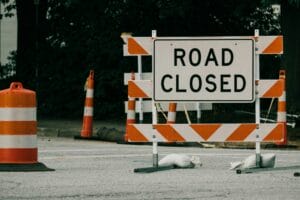The Maintenance of Traffic Plan (MOT) details the guidelines and directions for temporary traffic control during a construction project. Often referred to as an MOT plan, it provides temporary traffic control, extending traffic management solutions during construction activity.
The MOT plan ensures that construction projects do not inhibit the free flow of traffic. MOTs establish temporary traffic controls and authorizes work zones. Authorized personnel responsible for overseeing interim traffic control include flaggers, spotters, and traffic observers. MOT plans contain technical guidelines touching on side streets, crossroads, and roadways.
The parts of a traffic maintenance zone include:
- Advanced warning area: The advanced warning area cautions motorists of the prevailing work ahead. It cautions drivers of the distance required to merge into a single lane.
- Transition area: This area uses cones to form a merging taper that advances down the lane to force traffic into a single live lane. The transition area establishes a lateral buffer to ensure sufficient space between the workers and the oncoming traffic.
- Activity area: This is where construction takes place. It’s referred to as the work zone. The first section of this area is the buffer zone, protecting workers from oncoming traffic. The second section is located downstream and provides space for equipment, machinery, and construction. The construction zone is located adjacent to the buffer zone.
- Termination area: This is the end zone of construction. The termination area includes cones that officially mark the end of construction. While some roadside construction sites set cones without tapers, a clear indication is crucial for safety purposes.
The main requirements include:
- A typical section for construction zones must be offered for all construction projects. However, resurfacing, milling, and simple improvements do not require a typical section. The typical section must capture the construction area, barriers, land widths, and warning devices.
- The traffic maintenance plan must define warning signs and their locations. Engineers must designate signs and signals when establishing work zones. If there are no signs before the start of the project, specifying locations may not be a priority.
- Pavement markings for transitions and diversions should be highlighted. In most cases, motorists divert traffic using intersections. So, it’s important to provide raised pavement markers and guide strips for diversions.
- The location of temporary barriers and crash cushions must be detailed.
- There’s a need for temporary drainage during the construction phase.
- The traffic maintenance plan requires you to channelize devices at different locations including unusual maneuvers like detours and transitional points.
- Temporary signs and variable message signs are costly and so they must be specified in the Maintenance of Traffic (MoT) plan. The contractor must establish the appropriate location for signs based on potential conflicts and warning needs.
- Timing, actuation, and phasing may need to be revised and amended when there are existing traffic signs. These warning signs will need to be adjusted to optimize traffic operations during roadside construction.
The MOT plan contains guiding principles that help constructors and engineers maneuver complex traffic situations. For instance, in the Maintenance of Traffic plan, contractors are required to confine traffic within the limits of the construction project, including temporary project suspensions.
A Maintenance of Traffic plan requires that developers construct and maintain detours, providing safety and opportunities for road improvement. Detours also provide an alternative way to your destination.
Maintenance of Traffic requires engineers responsible for roadside construction to provide facilities for access to residences, organizations, and institutions. It’s the role of the contracting company to provide bridges to access critical facilities including hospitals, schools, and homes. Maintenance of Traffic (MOT) requires that contractors and engineers furnish, install and maintain safety and temporary traffic control.
The parties responsible for construction must provide special requirements for expeditious traffic flows. The MOT captures all operations, devices, and facilities required for the public’s convenience and safety within the work zone. So, it’s the responsibility of the engineer to create a safe work zone while facilitating free traffic flow.
What’s captured in a traffic maintenance plan?
The traffic maintenance plan considers workers’ safety while ensuring the overall well-being of pedestrians, cyclists, drivers, and persons with disabilities. The plan takes into account the location of the construction (work zone), timing (day or night), traffic, and road conditions. The MOT plan captures the facilities, services, and guides required to implement temporary traffic controls, specifically flaggers, law enforcement officers, and signage.
Maintenance of Traffic Plan Design
Each project comes with its own distinct set of challenges when it comes to designing maintenance of traffic plans. DFM Development Services’ in-house team understands the unique requirements of working in Virginia, Maryland, and Washington, D.C. Contact us today via our website or call us at 703-942-8700 to get started on your maintenance of traffic plan.




